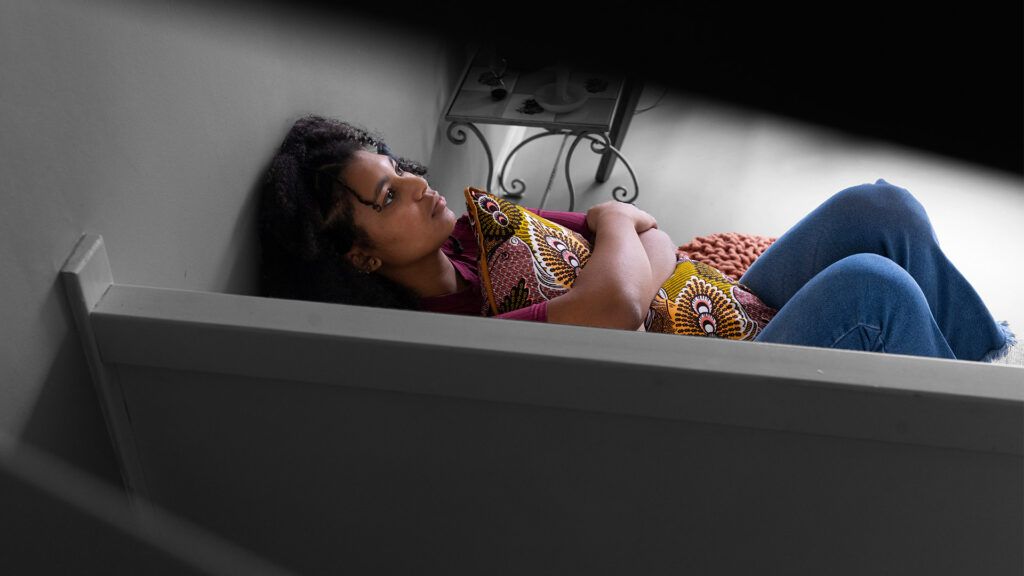Menstrual cramps may occur close to or during a period. Severe, longer lasting cramps may be a sign of a secondary condition, such as endometriosis or pelvic inflammatory disease.
The term for pain due to menstruation is dysmenorrhea. Dysmenorrhea can include menstrual cramps, causing pain or discomfort in the lower abdomen around the time of their period.
Menstrual cramps may be more likely at the start of a person’s period, when they have higher amounts of prostaglandins.
Menstrual cramps may also occur due to an underlying cause which affects the reproductive system. The term for this kind of menstrual pain is secondary dysmenorrhea.
This article explains symptoms of menstrual cramps, including when they may occur, how to find relief, and when to contact a doctor.

According to a
Menstrual cramps can occur due to increased levels of prostaglandins, which are hormone-like chemicals. Prostaglandins cause the uterus to contract in order to shed its lining.
At the start of a period, prostaglandin levels are higher, which can cause pain. This usually eases over the following few days as levels decrease again. The term for this cause of pain is primary dysmenorrhea.
According to Planned Parenthood, cramping tends to be worse at the beginning of a period, when the blood flow is likely to be heaviest.
Longer lasting cramps before a period
According to the American College of Obstetricians and Gynecologists, longer lasting pain around a period may indicate secondary dysmenorrhea, which means an underlying condition could be causing the pain.
This pain may start a few days before a period starts and may worsen as the period goes on. The pain may also continue after a period ends. Conditions that may cause secondary dysmenorrhea include:
- Endometriosis: In this condition, tissue that is similar to that of the uterus lining grows in another part of the body.
- Uterine fibroids: These are growths in or around the uterus.
- Adenomyosis: In this condition, tissue lining the uterus grows in the uterus muscle wall instead.
- Reproductive organ issues: This may include problems with organs such as the fallopian tubes or uterus.
Menstruation may also cause other health conditions to flare up and cause pain, such as urinary conditions or Crohn’s disease.
Cramping pain
Symptoms of menstrual cramps
People may experience cramping in the lower abdomen, but it may also affect the back or the legs. It may feel like an ache or a throbbing pain.
In some cases, people may also experience other symptoms, such as:
Menstrual cramps vs. early pregnancy cramps
Early pregnancy may also cause mild, temporary abdominal cramps or mild stomach pain. This can be due to:
- the uterus expanding
- ligaments stretching as the fetus grows
- hormonal changes
- bloating, constipation, or trapped wind
Cramps may feel similar to mild period pain or they can feel like having a stitch.
Pregnant people should get immediate medical help if they experience regular cramps or severe pain that does not go away after resting.
Ways to help ease painful period cramps may include the following:
- applying a warm heating pad on the area of discomfort
- taking a warm bath
- taking over-the-counter (OTC) pain relievers, such as:
- ibuprofen (Advil)
- acetaminophen (Tylenol)
- exercise
- relaxation techniques, such as:
- resting and getting enough sleep
- having an orgasm
- acupuncture or acupressure
- hormonal birth control
- transcutaneous electric nerve stimulation — a device that delivers a mild electrical current to the nerves to relieve pain
Certain supplements, including vitamin B1 or magnesium, may help to ease period pain but this requires further research.
If OTC pain relief medications and home remedies do not relieve menstrual cramps, or if cramps are severe and make it difficult to perform everyday activities, people can speak with a doctor.
Menstrual cramps that do not ease, worsen as a period continues, or continue after a period may indicate a secondary condition, particularly if other symptoms are also present.
A doctor can perform tests to check for any underlying causes that may be causing the pain and suggest treatment options.
Depending on the cause of pain, medications or medical procedures may help treat the underlying cause and painful symptoms.
Menstrual cramps can occur close to or during the start of a period, and can cause abdominal pain or discomfort. Some people may experience cramps a week or two before their period, which could indicate PMS.
Severe cramps that interfere with everyday life or cramps that worsen or continue after a period ends may indicate an underlying issue affecting the reproductive organs.
People can contact a doctor if they have any concerns about menstrual cramps or other period symptoms causing them pain or discomfort.
A doctor can suggest treatment options for managing pain as well as checking for any underlying causes.
